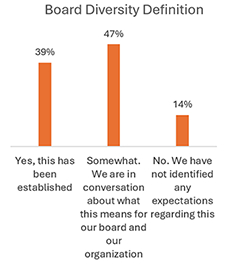Kansas City Area Board Diversity Research
The 2021 BoardSource report Leading with Intent: Reviewing the Current State of Diversity, Equity, and Inclusion on Nonprofit Boards includes findings at the national level. However, to date, there has been limited empirical data regarding the current state of diversity among nonprofit boards in the Greater Kansas City region.
Using a mixed methods survey design, this study assessed the level of diversity among nonprofit boards in the Greater Kansas City region to create a shared understanding of how the Greater Kansas City metro is aligned with the national research available, as well as to establish a baseline understanding of board diversity in the Kansas City region that can be referenced in the future.
The Midwest Center for Nonprofit Leadership collaborated with Support Kansas City on this research study with funding from The Ewing Marion Kauffman Foundation and the Kansas Health Foundation as part of the Board Diversity Initiative (BDI). BDI is dedicated to breaking down systemic barriers and celebrating diversity as the cornerstone of impactful governance. By embracing diversity, organizations unleash creativity, engage volunteers, and reach their full potential, driving meaningful change in the communities they serve.
Research Insights
- On average, boards are approximately 72% White and 28% Persons of Color
- 47% of board members are within the ages of 45-64
- Nearly 95% of organizations have only Cisgender male and/or Cisgender female board members.
- 45% of responding organizations have board members who identify as LGBTQIA+.
Most respondents report a strong importance (59%) at their organizations of focusing on diversity of their boards and inclusion of voices that represent the communities they serve. Most respondents feel the boards they are associated with generally represent the communities they serve (64%) and indicate a high priority on including a variety of experiences, voices, and demographic backgrounds when recruiting new board members. However, those responding also report demographics of their board members skewed white, cisgender, and more than half over the age of 45.
While the focus of diversifying boards, demographically, experientially, and in representation of the communities the organizations are serving from those receiving support or services to stakeholders that are partners, the outlook of boards is still skewed toward similar experiences and cultural backgrounds.
 Nearly two-thirds of respondents report that a formally identified expectation of what board diversity and representation would be for their board has yet to be formally established. There is consensus from respondents that this needs to be a focus and is a focus for their organizations, but the formal practice appears to be less established.
Nearly two-thirds of respondents report that a formally identified expectation of what board diversity and representation would be for their board has yet to be formally established. There is consensus from respondents that this needs to be a focus and is a focus for their organizations, but the formal practice appears to be less established.
Download the 2-Page Research Summary
Leaderships’ Views on Current State of Board Diversity
- Established leadership indicate relative ease in finding and recruiting a variety of perspectives and backgrounds to their boards, while admitting this would be very challenging for newer, less professionally established leadership and boards.
- Organizations that have prioritized board diversity and a range of experiences indicate positive growth in the organization’s direction.
- Executive Directors express a board’s need to consider diversity, experiences, skill sets, and representation by various definitions depending on the organization’s needs, and still trying to recruit members that are committed to the work of the organization.
- Some Executive Directors indicate a challenge in diversity requirements for certain funding opportunities.
Advice from Leadership Regarding Diverse Boards
- Encourage people to consider functional diversity. You want a diverse board not because you want a diverse board but because the guidance it brings actually helps move the organization forward.
- Seek out board members who want to represent and serve, not come from a perspective of saving.
- Focus on board members who can functionally help the board and the organization. Think about ’how can this individual help our organization.’
- Know your personal mission, the organization’s mission, and what drives a connection to that mission and then listen for that when meeting potential board members.
- Think about what it means to reflect the community the organization serves and also how best to help the work of the organization.
- Incorporate a variety of voices and perspectives to collaborate with the board: partnering groups to the board, advisory boards, volunteers, etc.


